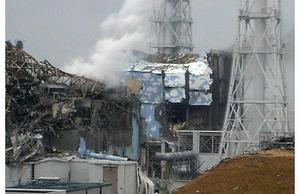Japan disasterCable connected to reactor no. 2, coolant pumps to be restarted
Tepco, the operator of the stricken reactors, says — and the IAEA confirms — that its engineers have been able to reconnect a power line to reactor no. 2; the 1-km cable connects to the main power grid; restoring power should enable engineers to restart the pumps which send coolant over the reactor and into the pools where radioactive waste is stored; Tepco said the process of reconnecting power could take up to fifteen hours; senior IAEA official Andrew Graham said the situation at Fukushima had not deteriorated, but could yet do so. He described the situation at “reasonably stable”; the head of the IAEA, Yukiya Amano, is heading to Tokyo to be briefed by Japanese officials

Structure containing spent-fuel storage pool // Source: edmontonjournal.com
In what appears to be the first bit of good news from Japan, engineers at Japan’s stricken Fukushima nuclear power plant have successfully connected a power line to reactor no. 2, the UN’s nuclear watchdog reports.
Restoring power should enable engineers to restart the pumps which send coolant over the reactor.
The Tokyo Electric Power Company (Tepco), which runs the plant, has been attempting to connect it to the main grid via a 1-km (0.6-mile) electricity cable. Once power is restored, engineers should be able to re-activate the pumps which send coolant through the reactors and the pools where spent fuel rods are stored.
The Vienna, Austria-International Atomic Energy Agency (IAEA) said the cable had reached the site by 17:30 local time (08:30 GMT) on Thursday, and that engineers planned to reconnect power to the reactor once workers have finished spraying seawater over reactor no. 3.
Tepco warned the process of reconnecting power could take up to fifteen hours.
Helicopters and water cannon have been dumping seawater over the Fukushima reactors, to try to prevent fuel rods melting. Video footage had suggested most of the water had been falling outside the target buildings, but a Tepco spokesman said it appeared the operation had had some success.
“When we poured water, we monitored steam rising from the facility. By pouring water, we believe the water turned down the heat. We believe that there was a certain effect,” a Tepco spokesman said.
Another spokesman said on Thursday that aerial observations of reactor 4 indicated it did contain some water. “We have not confirmed how much water was left inside but we have not had information that spent fuel rods are exposed,” he said.
Earlier, senior IAEA official Andrew Graham said the situation at Fukushima had not deteriorated, but could yet do so. He described the situation at “reasonably stable.”
The head of the IAEA, Yukiya Amano, is heading to Tokyo to be briefed by Japanese officials.
